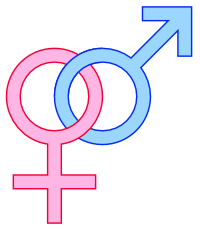Gender Equity
Contents
GENDER EQUITY
This section deals with the gender perspective in education.
|
Think that by 2030 around 30% more females wii be working than the their male counterparts. Think that with 50% of male contribution we have come to this scientific age.If the other 50% of the females (some times emotionally better of the males)who have been suppressed would have been contributed to this world what would have been our position?
|
|
After reading through this material and under going training you’ll be able to
|
SHARE THE SEX AND GENDER ISSUES WITH YOUR COLLEGUES.
WHAT IS GENDER PERSPECTIVE IN EDUCATION?
Now a days one reads a lot about women, gender, equality, empowerment and development in news papers, magazines, posters and pamphlets. The wide spread usage of these terms has not provided the conceptual clarity. Each one derives meaning according to one’s own perception. Therefore it is very essential to understand each of these terms and it’s connotations. The word “Gender” co notates “sex” to those who are neither aware nor read about “women’s issues”. But they have different meanings. “Sex is the biological difference between male and female. This difference is not 100% universal but varies by religion, culture, class, race, caste, ethnicity, nature of State and Public policy. The gender relations between men and women to a large extent determine the degree of differences in the different groups. For example, in lower caste group, mobility of a woman is acceptable but in a higher caste group, mobility for woman is not acceptable and hence the attitude is “women should be protected”. Because they are weak, they might be molested and so on and so forth. In this way many differences between men and women are socially constructed. To summarize;
These socially constructed differences are expressed through our language, play, beliefs and practices, proverbs, rituals, literature and media. These expressions are passed on from generation to generation and are rarely distorted, though there are no written rules regarding them. These conceived differences between men and women, are rarely/seldom violated. Thus male roles and female roles are established. This continuity over the years gives credibility to their perceptions. The social differences that are by and large, uniformly constructed are as follows.
- Women are physically weaker than men.
- The hormones in the female sex make them soft and emotional.
- Since they give birth to children they are more suitable to raise and nurture children.
- They have nimble fingers and hence can do delicate work.
There is no rationale behind these differences. Men and women reflect biological similarity in a greater degree than the biological difference. The similarities are in the process of birth, death, ageing, and in their response, to hunger, thirst, and sickness. Except the reproductive function all other functions are the same.
What is Women’s Status?
- In view of these perceived differences, there is no equality between men and women in our society, well, in most of the societies in this world. Our perceptions compel us to discriminate between males and females. Equality is the equal distribution of the resources between men and women. ‘Resources’ range from a ‘whole meal’ to ‘property’. The variation has a close correlation to socio-economic condition of the person. For a hungry and starving person, ‘food’ is the Resource and not so much the ‘dresses. For a person with a full stomach “Dress” could be a resource. “Equality” can therefore be defined as ‘a status’ either in private life or public life. – Where in the available resources are equally distributed between men and women.
- Women constitute nearly 50% of the population but still they do not get a fair share and thus are deprived of an equitable status. According to the world encyclopaedia published by oxford university press, 2/3 of the worlds work is turned out by women but only 1% of the worlds wealth is registered in the name of women.
- The discrimination made between the two sexes, commences from birth and continues after death too.
| You may like to visit this site |
- How many more gender roles were you able to identify? Keep adding to your list whenever you find a new role of each.
- Make a list of traditional gender roles at home ,Riverse those roles and suggest innitial adjustments you need to perform one of the roles.
PLEASE SEND YOUR REFLECTIONS TO YOUR ONLINE FACILITATOR AND TO
kumaraswamy64@gmail.com

